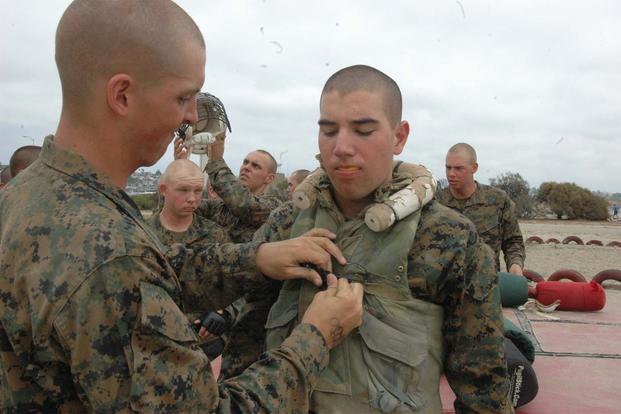QUANTICO, Virginia -- At Gruntworks, a warehouse-style test facility for infantry gear that abuts The Basic School aboard Quantico, Virginia, a handful of enlisted artillery Marines huddled around a general, talking gear.
"How do you carry that?" Brig. Gen. Joseph Shrader, head of Marine Corps Systems Command, said, gesturing to the 30-pound base plate of an 81-millimeter mortar.
"Strap it to your pack," a sergeant volunteered.
The Marines, instructors at The Basic School, nodded as Shrader proposed a load-bearing harness that might ease the weight of some of their artillery gear.
"Do you understand what we're trying to do?" Shrader said. "We're looking for your ideas."
In a service that has long professed "every Marine a rifleman" and sent grunts downrange with identical packs and protective gear, what Shrader and other Marine leaders are trying to do is fairly revolutionary.
At a first-of-its kind industry day Monday focused on equipping infantry troops, Shrader said he wants to develop specialized gear for each of the 12 military occupational specialties, from infantry assaultman to light armored vehicle crewman.
As part of an initiative spearheaded by Commandant Gen. Robert Neller, SYSCOM is looking for off-the-shelf and non-developmental technologies that will make Marines lighter and more efficient on the battlefield. And for the first time, they're doing it job by job, with plans to field gear selectively and strategically.
This first infantry equipping challenge calls on industry to consider the needs of Marines in six MOSs: rifleman, LAV crewman, machine gunner, mortarman, infantry assaultman, and infantry unit leader.
The hope, Shrader told Military.com, is to select a handful of technologies to test, and potentially field, within fiscal 2017, which begins Oct. 1. These solutions may be job-specific modifications to existing gear such as the pack and flak jacket, or innovations that take a page from other industries, like camping and shooting.
"I'm a bowhunter. I have a pack I put my bow in. It's designed for that specific purpose: to carry my bow, carry all my gear," Shrader said. "So that's the idea. If a Marine is a machine gunner, he goes down to supply to get his gear, and he gets the machine gunner's version of the pack, if you will, or maybe some things that we put on it to modify it so he can carry the tripod."
Sgt. Levi Lawrence, an operations chief for the infantry platoon at TBS, helped organize the industry day -- but also had a number of gear suggestions for the generals and executives.
"When we have our plate carriers on, the pack isn't exactly fitted to go right on top of the flaks that we have," Lawrence, a rifleman, said. "If we could get a different frame that molds around the plate carrier itself, that would be a lot easier."
He also recommended a less boxy shape for the flak jacket, or plate carrier, to improve maneuverability when firing weapons. Lawrence said he was eager, later that day, to talk to the makers of the gear he deployed with to share his experiences and notes.
"It helps us get out our problems, and hopefully they'll get fixed," he said. "More than just complaining all day, we can actually hopefully get something done with it."
Still unclear is how the Marine Corps will pay for the improvements it wants. There's no pot of money set aside for the initiative, and the service is already waiting to find out if "wish list" items, such as additional aircraft and combat helmets, will receive funding in the final version of next year's defense budget.
Those constraints are driving a more strategic plan for fielding new gear, said Brig. Gen. Roger Turner, director of the Marines' Capabilities Development Directorate.
"You may only do two battalions, maybe even specific MOSs, subsets where maybe, hey, we don't need to field this across all active component infantry battalions," Turner told Military.com. "Maybe it's only the [special purpose Marine air-ground task force] units, maybe it's only the [Marine expeditionary units], maybe it's the [unit deployment program] units, or whatever. This paradigm shift that we're working off of, is these very targeted investments might increase capacity and capability."
Gear selected for further study, whether it's a lighter and more efficient battery or a better moisture-wicking undergarment, may be sent to the Marines' experimental battalion -- 3rd battalion, 5th Marines -- for testing next year, Shrader said.
-- Hope Hodge Seck can be reached at hope.seck@military.com. Follow her on Twitter at@HopeSeck.
Related Video:
Semper Fi Always Faithful




























